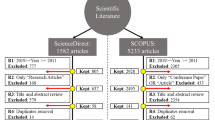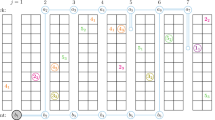Abstract
Stecke [21] has developed mathematical programming approaches for determining, from a set of part type requirements, the production ratios (part types to be produced next, and their proportions) which maximize overall machine utilizations by balancing machine workloads in a flexible manufacturing system (FMS). These mathematical programming (MP) approaches are aggregate in the sense that they do not take into account such things as contention for transportation resources, travel time for work-in-process, contention for machines, finite buffer space, and dispatching rules. In the current study, the sensitivity of machine utilizations to these aggregations is investigated through simulation modeling. For the situation examined, it is found that achieved machine utilizations are a strong function of some of the factors ignored in the MP methodology, ranging from 9.1% to 22.9% less than those theoretically attainable under the mathematical programming assumptions. The 9.1% degradation results from modeling with nonzero work-in-process travel times (i.e. 2 minutes per transfer) and using only central work-in-process buffers. Resource levels (e.g. the number of automated guided vehicles; the amount of work-in-process; the number of slack buffers) needed to limit the degradation to 9.1% correspond to FMS operating conditions which are feasible in practice.
Similar content being viewed by others
References
R. Akella, Y. Choong and S.B. Gershwin, Real-time production scheduling of an automated cardline, Ann. Oper. Res. 3(1985)403.
P. Afentakis, Maximum throughput in flexible manufacturing systems,Proc. 2nd ORSA/TIMS Conf. on Flexible Manufacturing Systems (Elsevier, Amsterdam, 1986) p. 509.
M. Berrada and K.E. Stecke, A branch and bound approach for machine load balancing in flexible manufacturing systems, Manag. Sci. 32, 10(1986)1316.
R.W. Conway, W.L. Maxwell and L.W. Miller,Theory of Scheduling (Addison-Wesley, Reading, MA, 1967).
J. Erschler, D. Lévêque and F. Roubellat, Periodic loading of flexible manufacturing systems,Proc. IFIP Congress APMS (Bordeaux, France, 1982).
S. French,Sequencing and Scheduling (Ellis Harwood Ltd., Chichester, England, 1972).
J.O. Henriksen and R.C. Crain,GPSS/H User's Manual, 3rd ed. (Wolverine Software Corporation, Annandale, VA, 1988).
S.S. Heragu and A. Kusiak, Machine layout problem in flexible manufacturing systems, Oper. Res. 36, 2(1988)258.
K.L. Hitz, Scheduling of flexible flow shops — II, Report LIDS-FR-1049, Laboratory of Information and Decision Systems, MIT, Cambridge, MA (1980).
A. Kusiak, The part families problem in flexible manufacturing systems, Ann. Oper. Res. 3(1985)279.
A.M. Law and S.G. Vincent,UNIFIT User's Manual (Simulation Software and Analysis, Tucson, AZ, 1986).
O.Z. Maimon and S.B. Gershwin, Dynamic scheduling and routing for flexible manufacturing systems that have unreliable machines, Oper. Res. 36, 2(1988)279.
M.L. Pinedo, B. Wolf and S.T. McCormick, Sequencing in a flexible assembly line with blocking to minimize cycle time,Proc. 2nd ORSA/TIMS Conf. on Flexible Manufacturing Systems (Elsevier, Amsterdam, 1986) p. 499.
B. Schmeiser, Batch size effects in the analysis of simulation output, Oper. Res. 30, 3(1982)556.
T.J. Schriber,Simulation Using GPSS (Wiley, New York, 1974).
T.J. Schriber, A GPSS/H model for a hypothetical flexible manufacturing system, Ann. Oper. Res. 3(1985)171.
T.J. Schriber and K.E. Stecke, Machine utilizations achieved using balanced FMS production ratios in a simulated setting, Working Paper 486, Graduate School of Business, The University of Michigan, Ann Arbor, MI (1986).
T.J. Schriber and K.E. Stecke, Using mathematical programming and simulation to study FMS machine utilizations,Proc. 1987 Winter Simulation Conf. (Society for Computer Simulation, San Diego, CA, 1987) p. 725.
J.G. Shanthikumar and K.E. Stecke, Reducing work-in-process inventory in certain classes of flexible manufacturing systems, Eur. J. Oper. Res. 26(1986)266.
K.E. Stecke, Design, planning, scheduling, and control problems of flexible manufacturing systems, Ann. Oper. Res. 3(1985)3.
K.E. Stecke, Procedures to determine both appropriate production ratios and minimum inventory requirements to maintain these ratios in flexible manufacturing systems, Working Paper 448, Graduate School of Business, The University of Michigan, Ann Arbor, MI (1988).
K.E. Stecke and I. Kim, A flexible approach to implementing the short-term FMS planning function,Proc. 2nd ORSA/TIMS Conf. on Flexible Manufacturing Systems (Elsevier, Amsterdam, 1986).
K.E. Stecke and I. Kim, Decision aids for FMS part type selection using aggregate production ratios to study pooled machines of unequal sizes, Working Paper 478, Graduate School of Business, The University of Michigan, Ann Arbor, MI (1986).
K.E. Stecke and I. Kim, A study of unbalancing and balancing for systems of pooled machines of unequal sizes,Proc. IEEE Robotics and Automation Conf. (Raleigh, NC, 1987).
K.E. Stecke and I. Kim, A study of FMS part type selection approaches for short-term production planning, Int. J. FMS 1, 1(1988).
K.E. Stecke and J.J. Solberg, Loading and control policies for a flexible manufacturing system, Int. J. Prod. Res. 19, 5(1981)481.
R. Suri, An overview of evaluative models for flexible manufacturing systems, Ann. Oper. Res. 3(1985)13.
R. Suri and J.W. Dille, A technique for on-line sensitivity analysis of flexible manufacturing systems, Ann. Oper. Res. 3(1985)381.
C.K. Whitney and T.S. Gaul, Sequential decision procedures for batching and balancing in FMSs, Ann. Oper. Res. 3(1985)301.
R.J. Wittrock, Scheduling algorithms for flexible flow lines, IBM Journal of Research and Development 29, 4(1985)401.
Author information
Authors and Affiliations
Rights and permissions
About this article
Cite this article
Schriber, T.J., Stecke, K.E. Machine utilizations achieved using balanced FMS production ratios in a simulated setting. Ann Oper Res 15, 227–267 (1988). https://doi.org/10.1007/BF02186798
Issue Date:
DOI: https://doi.org/10.1007/BF02186798




